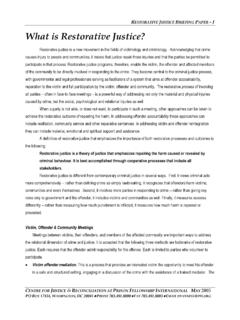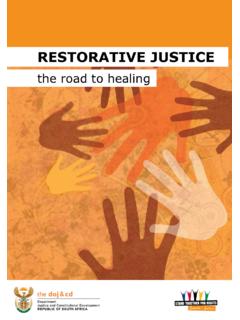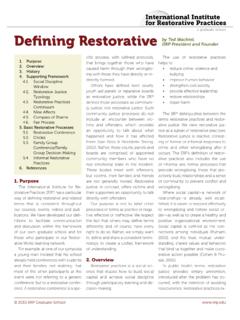Transcription of Restorative Justice Training: Peace Circles
1 1 Restorative Justice training : Peace Circles A guide to facilitating and utilizing Peace Circles Overview p. 1-3 Facilitation Guide p. 3-6 Application of Peace Circles p. 6-7 Doing this Peace circle, I ve been able to express myself and come up with ways to help me fix my problems. I can learn from others' mistakes and they can learn from mine. It s a give and take situation. Anthony Ricks, 21 2 Overview What is a Peace Circle? A Peace circle is a Restorative Justice model that, like other Restorative Justice practices, can be used to address conflict holistically and solve problems.
2 Peace Circles emphasize healing and learning through a collective group process, aiming to repair harm done and assign responsibility by talking through the Peace Circles combine victim reconciliation, offender responsibility, and community healing. What does it look like? At a Peace circle, a minimum of 3 participants sit in a circle of chairs, ideally without tables or other obstructions between them. They use a talking stick to take turns speaking and determine (1) what happened and why, and (2) how it can be fixed. Peace Circles can be used in a myriad of settings including schools, neighborhoods, workplaces, among family and friends, and in the juvenile and criminal legal systems.
3 Ii Discussion and resolution of the problem may be achieved in a single session, but Peace Circles may extend into multiple sessions until genuine consensus is reached. Circle processes are simple and organic but certainly cannot be facilitated in a pinch and are by no means, an easy way out . How can SPA chapters use them? Peace Circles can be used in a myriad of ways by SPA chapters and members. You can use these Circles to deal with internal conflicts, and you can also provide them as a service to other student organizations, judiciary proceedings, classes or on-campus conflicts. This will help you to build SPA s on-campus visibility.
4 Further, the principles Peace Circles such as listening, hearing, communicating and healing lay a perfect groundwork upon which to build yourselves as a community of activists and decision makers. What beliefs underlie Peace Circles ? Positive potential and rehabilitation. Humans are interdependent. We have a responsibility to help one another. People are inherently good even if they make bad choices. Punishment disrupts victims. What does a Peace circle do that other processes tend not to? Transforms relationships Gives everyone a voice Resolves conflict in a non-punitive, rehabilitative way Inspires taking responsibility to repair harm done Grows and transforms relationships (interpersonally and in communities) Builds consensus and empathy Creates opportunity for individual growth Allows leaders to emerge naturally 3 Develops problem-solving skills Explores issues holistically, in context, and at-depth Offers a safe space of equitable power sharing and mutual respect Goes beyond the mundane and the ordinary Where did Peace Circles come from?
5 Peace Circles started to surface in the United States in the 1970s. However, they have been around much longer than that. Peace Circles are largely based on talking Circles and carry with them the history of cultural traditions from all over the world. Indigenous peoples of Turtle Island, Nigeria, Kenya, and Uganda, to name a few, used Peace Circles for conflict-resolution. Today, communities are beginning to adopt and adapt Restorative practices like Peace Circles to systems that, for centuries, have used more punitive, judiciary measures to address conflict and violence. Why should I use Peace Circles ?
6 Peace Circles give you the full picture by hearing every side of the story. Peace Circles are holistic and engage multiple aspects of human life. They use logic to resolve problems and require pathos or human emotion, connection, empathy, and understanding. o A Peace circle can hold: anger, anxiety, distrust, hope, faith, fear, love Facilitation Guide Step 1: Logistics of Peace Circles Participants: At least two people involved in a conflict Observers or community members Circle Keeper Four Stages of the Peace Circle: These are the stages typically seen in a Peace circle process. 1.
7 Acceptance: Is the circle process appropriate for the given situation? Has everyone accepted that is a process they want to participate in? 2. Preparation: As circle keeper, conduct private conversations with involved persons to explore potential issues and to prepare all parties to participate in the Peace circle process. 3. Gathering: All parties come together in the Peace circle to express their feelings and find solutions. 4. Follow-up: Regular communication and check-ins are used to assess progress and adjust agreements as necessary after the Peace circle is completed. Three Basic Guiding Questions: 1.
8 What harm has been experienced? 2. What led to the harm happening, or why was this issue experienced as harm? 3. How might this harm be healed? 4 4. How might this harm be prevented in the future? Role of the Circle Keeper: Unlike other Restorative Justice models such as victim-offender mediation in which the facilitator is a driving force moderating the conversation, in Peace Circles the keeper plays a less prominent role. The circle keeper acts as a participant and witness to the process as much as a facilitator, and as a result must step back in order to allow the group to reach true, autonomous consensus.
9 The keeper asks questions and intervenes in lulls or during particularly heated interactions, all while allowing discussion to flow naturally and the group to steer its direction. A circle keeper must model the behavior expected of participants by, for example, using a respectful tone of voice and limiting speaking time in order to allow others time to voice their opinions. Keepers should also praise participants for their responses and for their bravery in dealing with the issue in a public manner and encourage others who are shy to speak up. Step 2: Preparation Facilitating a Peace circle requires preparation and intentionality.
10 The preparation that is done should vary with the group and the scenario that is being worked through. That said, there are certainly some basic models that are applicable to most Peace Circles . Once you have done the preparation of determining if a circle is right for the scenario and checking in with all parties, you can consider the following preparation steps. Develop a Ritual: Marking the Peace circle as a special, meaningful event makes reaching resolution easier. o One way to do this is with distinct openers and closers that demarcate the time and space of the event- such as reading a poem, or closing your eyes together to take deep breaths before and after.







